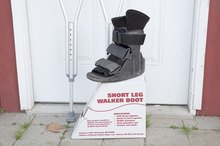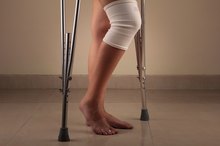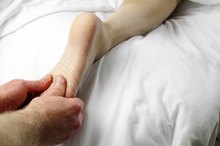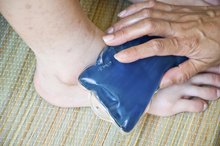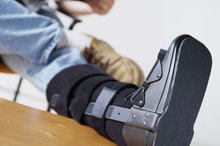How to Walk After a Hip Replacement
A hip replacement is major surgery in which your eroded or otherwise damaged hip joint is replaced with a synthetic ball and socket. Arthritis is a common cause for hip damage that leads to total joint replacement. Walking after a hip replacement is painful and difficult at first, but will get easier as you recover.
Begin walking as soon as you are cleared to do so by your surgeon, probably in the first day or two after surgery. The American Academy of Orthopaedic Surgeons--AAOS--explains that getting back on your feet at an early stage in recovery helps your hip muscles recover from the trauma of surgery. You'll be aided by a walker and medical personnel during your first attempts to walk post-surgery.
How to Wear a Walking Boot & Use Crutches
Learn More
Stand in the middle of your walker with your weight balanced evenly between the two sides of the apparatus. Grasp the walker with both hands--one hand on each side--and move it ahead of you just a little bit. Take a small step with your affected leg; when you step down, make sure your heel hits the floor before the sole of your foot or your toes. Follow with your healthy leg and repeat the process slowly.
Take it easy as you walk after your hip replacement. You'll be able to move more quickly and put more weight on your healing leg as you recover and gain strength.
How to Straighten a Leg Easier After a Total Knee Replacement
Learn More
Graduate to using a cane or one crutch in place of the walker a few weeks after surgery, according to AAOS. Your doctor will check your progress to see if you can carry your full weight while standing, without leaning on the walker, before giving the green light for a single crutch. Hold the cane or crutch on your healthy side to lend support to your hip replacement. For example, if your left hip was replaced, use the cane on your right side.
Walk up and down stairs only when there is a bannister to give you support, until you're fully healed. Walk up the stairs as a child would, placing your good leg on a step and bringing your ailing leg up to meet it. Reverse the process to go downstairs; lead with your healing leg and then bring your good leg down each step.
Continue to use mobility devices to help you walk until your doctor or physical therapist feels you're ready to walk unassisted. The recovery process can take between 3 and 6 months in some cases, according to the National Institute of Arthritis and Muscoloskeletal and Skin Disease, or NIAMS.
Walk for exercise after you've fully recovered from your hip replacement. NIAMS explains that walking is a good workout because it builds up your hip and leg muscles. The low impact level of walking can protect your synthetic joint from injury.
Related Articles
References
Writer Bio
Erica Roth has been a writer since 2007. She is a member of the Society of Professional Journalists and was a college reference librarian for eight years. Roth earned a Bachelor of Arts in French literature from Brandeis University and Master of Library Science from Simmons College Graduate School of Library and Information Science. Her articles appear on various websites.
